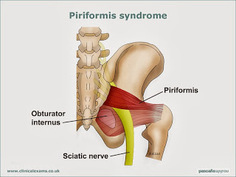To fully understand Sciatica, you first need to know what the sciatic nerve is. The sciatic nerve is the longest nerve in the body and is actually composed of two nerves, the common fibular (or peroneal) nerve and the Tibial nerve. These nerves are originally formed from 5 different nerve roots in the lower lumbar spine and pelvis. These nerves join together then run down the back of the thigh to knee level where they split and one travels down the front of the lower leg and one travels down the back of the lower leg.
Lets look a bit deeper and see how sciatica occurs, how you diagnose it and most importantly, how to fix it.

Sciatic pain occurs when there is pressure on or damage to the sciatic nerve. This impingement can commonly occur due to disc herniation’s, osteoarthritis, lumbar facet joint dysfunction or some muscle spasms. A common muscle that can impinge the sciatic nerve is the Piriformis Muscle. When this muscle irritates the nerve it is commonly called Piriformis Syndrome.
Less common causes include misplaced intramuscular injections, vertebral or pelvic fractures, back labour and tumours.
What are the signs and Symptoms?
The symptoms from sciatic pain can be mild to severe and can occur abruptly or worsen over time.
Common signs and symptoms are lower back pain, pain or loss of sensation along the path of the nerve from the buttocks, posterior thigh (back of the thigh), leg and foot. Weakness of hip extension and knee flexion. Foot drop (the inability to lift the foot up) can also occur.
If the sciatic nerve is irritated in the lower back the radiating pain in the leg often goes below the knee. If the
nerve is irritated by the Piriformis muscle, the pain will usually only go the knee level.
The pain is often worsened in certain positions and with coughing and sneezing. If there is a change to bowel or bladder control, immediate medical attention should be sought.
How is it diagnosed?
When I see someone with Lower back or leg pain, the first step in any diagnosis is to take a proper medical history. This includes how it occurred, what it feels like, what makes it better or worse, treatment to date etc. I will assess the neurological system including reflexes, muscles strength, dermatomes (skin sensation), general joint function, muscle tension etc. Depending on the results of these tests we may need to refer you for appropriate imaging such x-rays or a MRI scan.
Based on all of the findings I will make a working diagnosis and devise a treatment plan.
How do you fix it?
The treatment plan will depend on the cause of the nerve irritation. In any case, the first goal is to help manage the pain. This can be achieved through at home activities such as ice or heat, massage, pain control etc.
From a chiropractic perspective, I will look at restoring joint function and nervous system integrity through appropriate chiropractic adjustments. I will also show you appropriate stretches and exercises to do. These will help ease the discomfort early on and help prevent relapses once it has settled down.
Depending on the cause of the problem, you may need to modify daily activities. These will be things like changing how you sit down and stand up, modifying how you get out of a bed etc. You do need to move, but just avoid compromising positions and heavy physical work. According to Southern Cross, only about 5% of people with sciatica need surgery. Keep a look out for a follow up post on back surgery and its effectiveness.
Prevention
If you have never had sciatic pain before, you would likely want to try and avoid getting it. If you have had in the
past you probably don’t want to have it again. So how can you prevent it?
From my chiropractic perspective, you need to make sure you are functioning well initially and then more importantly, maintain that good function. This can be achieved through:
- Regular chiropractic care
- Regular stretching and appropriate exercises (especially core exercises)
- Good posture and movement patterns
- Safe lifting techniques
- Minimising poor posture when sitting. If you are sitting a lot, then you need to make sure you move regularly.
If you are suffering from sciatic pain and would like to have it assessed then contact me and we can get you started on your road to recovery. If you have had sciatic pain in the past or get regular flare ups, maybe it is time
to take a different, proactive approach. Call me today to find out more.



 RSS Feed
RSS Feed


